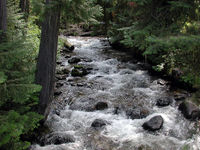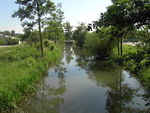Tributary

A tributary or affluent[1] is a stream or river which flows into a main stem (or parent) river. A tributary does not flow directly into a sea, ocean, or lake. Tributaries and the mainstem river serve to drain the surrounding drainage basin of its surface water and groundwater by leading the water out into an ocean or some other large body of water.
A confluence is where two or more bodies of water meet together, usually referring to the joining of tributaries.
Reciprocal to a tributary is a distributary, a river that branches off of and flows away from the main stream. Distributaries are most often found in river deltas.
Contents |
Terminology

'Right tributary' and 'left tributary' (or 'right-bank tributary' and 'left-bank tributary') are terms stating the position of the tributary relative to the flow of the mainstem river. These terms are defined from the perspective of looking downstream (in the direction the water current is going).
Ordering and enumeration

In orography, tributaries are ordered from those nearest to the source of the river to those nearest to the mouth of the river.
The Strahler Stream Order examines the arrangement of tributaries in a hierarchy of first, second, third, and higher orders, with the first order tributary being typically the least in size. For example, a second order tributary would be composed of two or more first order tributaries combining to form the second order tributary.
See also
- Distributary
- Estuary
References
- ↑ "affluent". The American Heritage Dictionary of the English Language, Fourth Edition. Houghton Mifflin Company, 2004. Viewed 30 Sep. 2008.